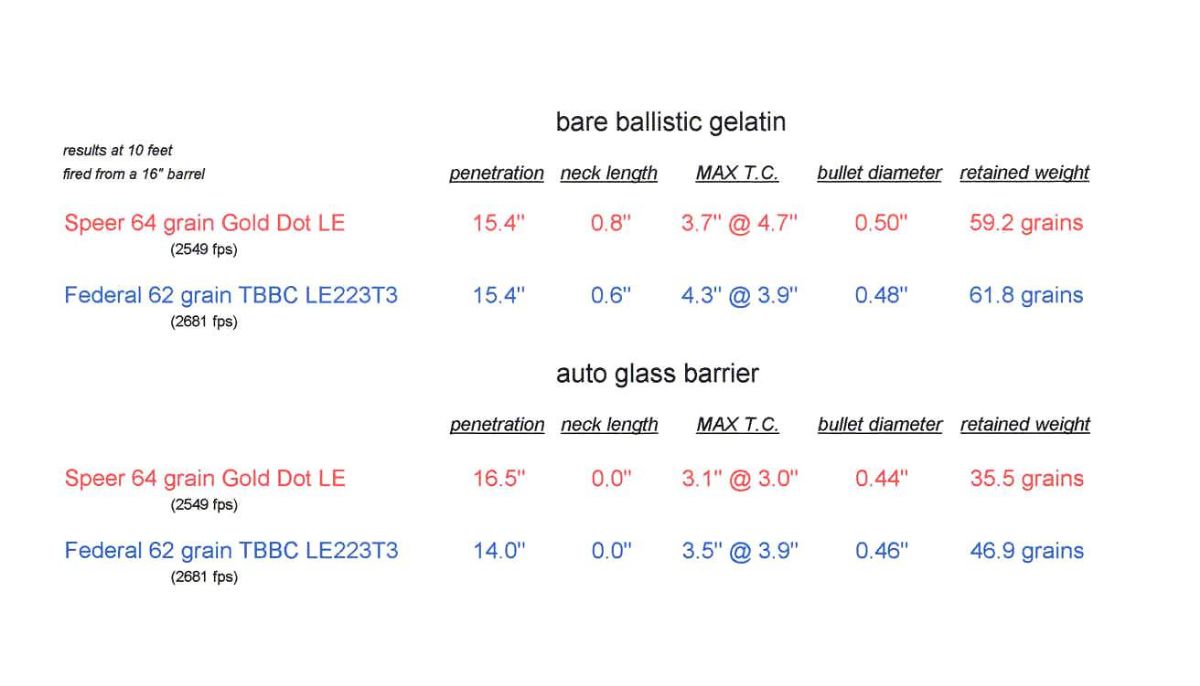The 62 grain Fusion projectiles have the same terminal ballistic properties as the 62/64 grain Gold Dot porjectiles.

 Federal 62 Grain Fusion
Federal 62 Grain Fusion vs
Federal 62 Grain Fusion MSR vs
Speer LE 62 Grain Gold Dot

The muzzle velocities shown in the tables below were obtained back-to-back during the same chronograph session using recent lots of all three of the Fusion/Gold Dot loads chrongographed.
Atmospheric Conditions
Temperature: 73 degrees F (plus or minus one degree)
Barometric Pressure: 29.68 inches of Hg
Humidity: 62%
Altitude: 950 feet above sea level
Muzzle velocities from a 20” Colt M16A2 barrel with a NATO chamber, chrome lining and a 1:7” twist.

Muzzle velocities from a 14.5 Noveske N4 light barrel with a NATO chamber, chrome lining and a 1:7’ twist.

10-shot groups were fired from one of my precision AR-15s with a Lothar-Walther barrel with a 223 Wylde chamber and a 1:8” twist. The groups were fired from the bench at a distance of 100 yards
with the same sight settings on the scope for each of the three groups.



.

Left to right: 1. 62 grain Fusion, 2. 62 grain Gold Dot, 3. 64 grain Gold Dot, 4. 75 grain Gold Dot
...
Speer LE 64 Grain Gold Dot ICE (#24447)

This review looks at the Immigration and Customs Enforcement (ICE) 223 Remington loading of the Speer 64 grain “bonded” soft-point (#24447).

Left to right: 1) 62 grain Fusion, 2) 62 grain Gold Dot, 3) 64 grain Gold Dot, 4) 75 grain Gold Dot.

This ammunition comes loaded in brass cases. The primer pockets are crimped and sealed. The case-mouth is crimped but is not sealed. The round is charged with a ball powder. The case-head reads:
SPEER 13 223 REM
 Velocity
Velocity
I chronographed the Speer LE 64 grain Gold Dot ICE ammunition from a semi-automatic AR-15 with a chrome-lined, NATO chambered, 20” Colt M16A2 barrel.

Chronographing was conducted using an Oehler 35-P chronograph with “proof screen” technology. The Oehler 35P chronograph is actually two chronographs in one package that takes two separate chronograph readings for each shot and then has its onboard computer analyze the data to determine if there is any statistically significant difference between the two readings. If there is a difference, the chronograph “flags” the shot to let you know that the data is invalid. There was no invalid data flagged during this testing.
The velocity stated below is the muzzle velocity as calculated from the instrumental velocity using Oehler’s Ballistic Explorer software program. The string of fire consisted of 10 rounds over the chronograph.


Each round was single-loaded and cycled into the chamber from a magazine fitted with a single-load follower. The bolt locked-back after each shot allowing the chamber to cool in between each shot. This technique was used to mitigate the possible influence of “chamber-soak” on velocity data. Each new shot was fired in a consistent manner after hitting the bolt release. Atmospheric conditions were monitored and recorded using a Kestrel 4000 Pocket Weather Tracker.
 Atmospheric conditions
Atmospheric conditions
Temperature: 76 degrees F
Humidity: 33%
Barometric pressure: 30.05 inches of Hg
Elevation: 950 feet above sea level
The muzzle velocity for the 10-shot string of the Speer LE 64 grain Gold Dot ICE ammunition fired from the 20” Colt barrel was 2830 FPS with a standard deviation of 19 FPS and a coefficient of variation of 0.67%.
For those of you who might not be familiar with the coefficient of variation (CV), it is the standard deviation, divided by the mean (average) muzzle velocity and then multiplied by 100 and expressed as a percentage. It allows for the comparison of the uniformity of velocity between loads in different velocity spectrums; e.g. 77 grain loads running around 2,650 fps compared to 55 grain loads running around 3,250 fps.
For comparison, the mil-spec for M193 allows for a coefficient of variation of approximately 1.2%, while one of my best 77 grain OTM hand-loads, with a muzzle velocity of 2639 PFS and a standard deviation of 4 FPS, has a coefficient of variation of 0.15%.
 Accuracy
Accuracy
I conducted an accuracy (technically, precision) evaluation of the Speer LE 64 grain Gold Dot ICE ammunition following my usual protocol. This accuracy evaluation used statistically significant shot-group sizes and every single shot in a fired group was included in the measurements. There was absolutely no use of any group-reduction techniques (e.g. fliers, target movement, butterfly Shots).
The shooting set-up will be described in detail below. As many of the significant variables as was practicable were controlled for. Also, a control group was fired from the test-rifle used in the evaluation using match-grade, hand-loaded ammunition; in order to demonstrate the capability of the barrel. Pictures of shot-groups are posted for documentation.
All shooting was conducted from a concrete bench-rest from a distance of 100 yards (confirmed with a laser rangefinder.) The barrel used in the evaluation was free-floated. The free-float handguards of the rifle rested in a Sinclair Windage Benchrest, while the stock of the rifle rested in a Protektor bunny-ear rear bag. Sighting was accomplished via a Leupold Competition Series 45x45mm scope adjusted to be parallax-free at 100 yards. A mirage shield was attached to the objective-bell of the scope. Wind conditions on the shooting range were continuously monitored using a Wind Probe. The set-up was very similar to that pictured below.

The Wind Probe.

The test vehicle for this accuracy evaluation was one of my Krieger barreled semi-automatic AR-15s. The barrel has a 5.56mm Match chamber with a 1:7.7” twist. Prior to firing the 64 grain Gold Dot ICE ammunition, I fired a 10-shot control group using match-grade hand-loads topped with the Sierra 55 grain BlitzKing. That group had an extreme spread of 0.68”.


Three 10-shot groups of the Speer LE 64 grain Gold Dot ICE ammunition were fired in a row with the resulting extreme spreads:
1.36”
0.98”
1.16”
for a 10-shot group average extreme spread of 1.17”. The three 10-shot groups were over-layed on each other using RSI Shooting Lab to form a 30-shot composite group. The mean radius for the 30-shot composite group was 0.36”.
The smallest 10-shot group . . .

The 30-shot composite group . . .

And for any Internet Commandos in our viewing audience today, here’s a pic of a 3-shot group of the 64 grain Gold Dot ICE load. The group has an extreme spread of 0.16”.

.....




 Reply With Quote
Reply With Quote





























